These Traditional Parkin Biscuits have all the tasty flavours of an English Parkin Cake. Parkin biscuits are packed with the festive flavours of rich ginger, cinnamon, oatmeal, and treacly syrup, and topped with a toasted nutty almond. If you love the flavour of a British oaty hobnob biscuit or ginger nuts then you'll also like these Parkin biscuits with their crisp edges and softer chewy insides. Perfect for dunking in a nice cuppa tea.

This recipe for Parkin biscuits is prepared with vegan-friendly ingredients as they do not require dairy or eggs. A few everyday pantry ingredients are all that is required. During the past few years the price of groceries has sky-rocketed especially the cost of butter and eggs so many more people are beginning to release that tasty traditional bakes can be prepared more economically with no costly eggs required. Although the frugal British home cooks of the 1940's war years of food rationing and shortages, and the US 1930's Great Depression eras, already worked this one out as many egg-free and dairy-free recipes were popular during those times.
Jump to:
What is a Parkin cake?
In essence, Parkin is a dense, rich type of gingerbread which although it is at first drier than gingerbread, the Parkin does becomes more moist and sticky as it ages, so the cake tends to be baked several days or even a week before it is eaten.
Parkin cake originates in Northern England most notably Yorkshire and Lancashire where the two regions have slight variations in the cake ingredients. A Yorkshire Parkin contains black treacle and medium oatmeal, which often creates a drier biscuit-like cake whereas the Lancashire Parkin usually features golden syrup and rolled oats.
Parkin cake is traditionally baked for the Halloween festivities, as well as Bonfire Night or Guy Fawkes Night on the 5th November, where it is traditional to eat a slice of Parkin along with a mug of milk in front of the bonfire. Although Parkin is nice at any time during the autumn and winter months, and if you're a Parkin fan then you can enjoy Parkin at any time of the year. Parkin does keep well in the cake tin.
Another good time of year to enjoy Parkin cake or indeed Parkin biscuits is during Beltane which is an ancient Celtic fire festival that marks the coming of summer. Bonfires are lit on the 1st May, or when the moon rises on the 30th April, and these fires represent that the sun is becoming stronger as the seasons begin to change, the cleansing and purification of the people and their land, and ensuring that both the land and it's people will enjoy good fertility.
Packing up a batch of home-baked Parkin biscuits, filling a flask with hot tea, wrapping up warm as April in Scotland or Ireland is still quite chilly, and going out to watch the Beltane bonfire is a nice way to mark the ending of spring and the coming of summer. If you're lucky enough to be in Edinburgh on Wednesday 30th April, 2025 then you can see the Beltane Fire Festivals on Carlton Hill.
📜 Origin of parkin
Mentions of Parkin date back to the 1700s but the origins of the cake date back to British Medieval times where a Tharf cake, bread, or biscuit was baked. In the North of England, oats was a cheaper grain to grow compared to wheat, and so when the oats were harvested at the beginning of November the Tharf cake or biscuit was baked.
Other names for the tharf cake was Thor cake or Tharve cake and the name is said to translate from Old English to mean unleavened or plain as the cake resembles a flat biscuit.
Historically, tharf cakes were also eaten during the Twelfth night or Twelve days after Christmas, and traditionally on the 1st November on All Saints Day or 2nd November, during All Souls Day. Other traditional medieval biscuits for All Souls Day are Soul Cakes which are a crisp biscuit that also contain oatmeal and spices.
In some English villages the first of November was also known as Caking Day and the males of the town would go from door to door asking for money so that they could purchase Tharf cakes!
Nowadays, there are many variations of Parkin and lots of different family recipes which results in many variations - including Parkin biscuits.

There's nothing better or tastier than a few traditional Parkin biscuits with a nice cup of strong brewed tea. As Parkin cake and Parkin biscuits likely evolved from medieval Tharf or Thor biscuit-like cakes our Parkin biscuits are a bite of delicious history. The best thing about Parkin biscuits is that their flavour and texture deliciously develop as they sit in the biscuit tin just like a Parkin cake, so they are the ideal bake for filling up the cookie jar.
🍪 Be-Ro Parkin biscuits
Our recipe for Parkin biscuits is adapted from an old Be-Ro recipe that was found in the 18th edition of the Be-Ro vintage recipe booklet, published in 1955. Be-Ro is a British flour company that was founded in 1875. Over the years, Be-Ro have produced popular Be-Ro recipe booklets filled with tasty sweet and savoury baking recipes as well as amassing a loyal fan of bakers.
The original Be-Ro Parkin biscuit recipe featured eggs, dark syrup, dairy milk, and less spices. For our adaption we added more syrup in the form of black treacle, and more milk albeit we used soya milk, and the spices were increased from one teaspoon of ginger to two teaspoons, and a teaspoon of cinnamon was also included.
The original recipe did not contain baking powder or salt, but our egg-free adaption does include baking powder to give the biscuits a little lift during baking and a wee pinch of salt to aid the baking powder.
Additionally the original recipe states to rub the margarine into the dried ingredients to create a breadcrumb like texture, however we melted the margarine and simply mixed it into the dry ingredients along with the treacle and milk, and this different method worked well for our Parkin biscuits.
Ingredients
The ingredients you will need for this biscuit recipe are:
- plain flour
- caster or granulated sugar
- medium oatmeal [also known as steel-cut oatmeal/Irish oatmeal/pinhead oatmeal]
- baking powder
- ground ginger
- ground cinnamon
- salt
- margarine or butter [we used Stork baking spread]
- treacle [or molasses]
- milk [we used soya milk but any milk will do]
Optional topping:
- whole or halved almonds
🥣 How to prepare
These Parkin biscuits are simple to prepare as the biscuit dough does not require pre-chilling before being formed into biscuits and baked for a quick 15 minutes.
Parkin biscuits are perfect for when you have a after for the flavours of traditional Parkin cake but don't want to switch the oven on for an hour or longer to bake the cake and then wait days for the cake to develop in the cake tin.
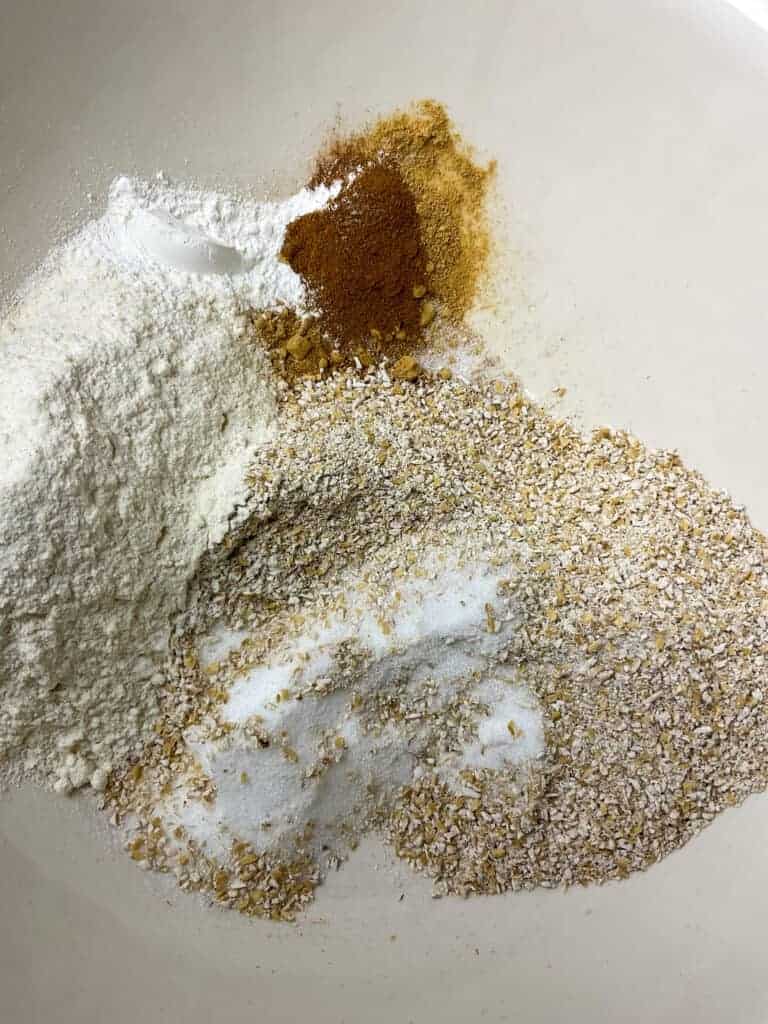
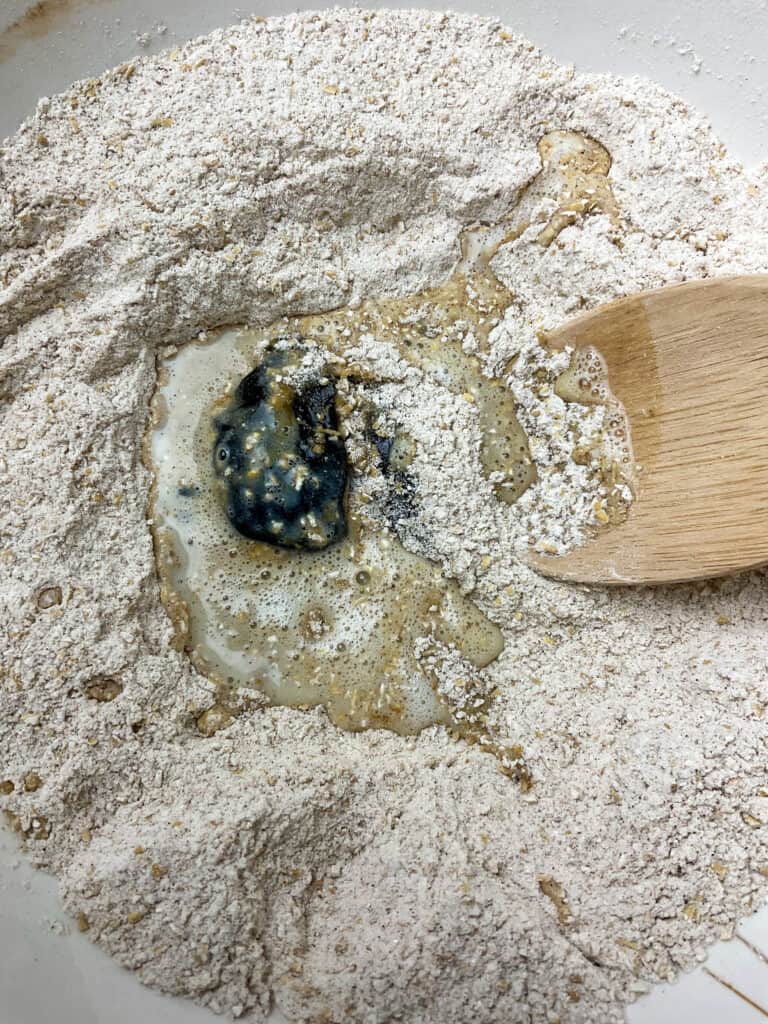
Step 1: Melt the margarine in a small saucepan and set aside.
Step 2: Add the medium oatmeal, plain flour, baking powder, caster sugar, pinch of salt, and ginger and cinnamon powders to a mixing bowl and stir well.
Step 3: Next, add the black treacle [or molasses or golden syrup] and soya milk [or your usual milk].
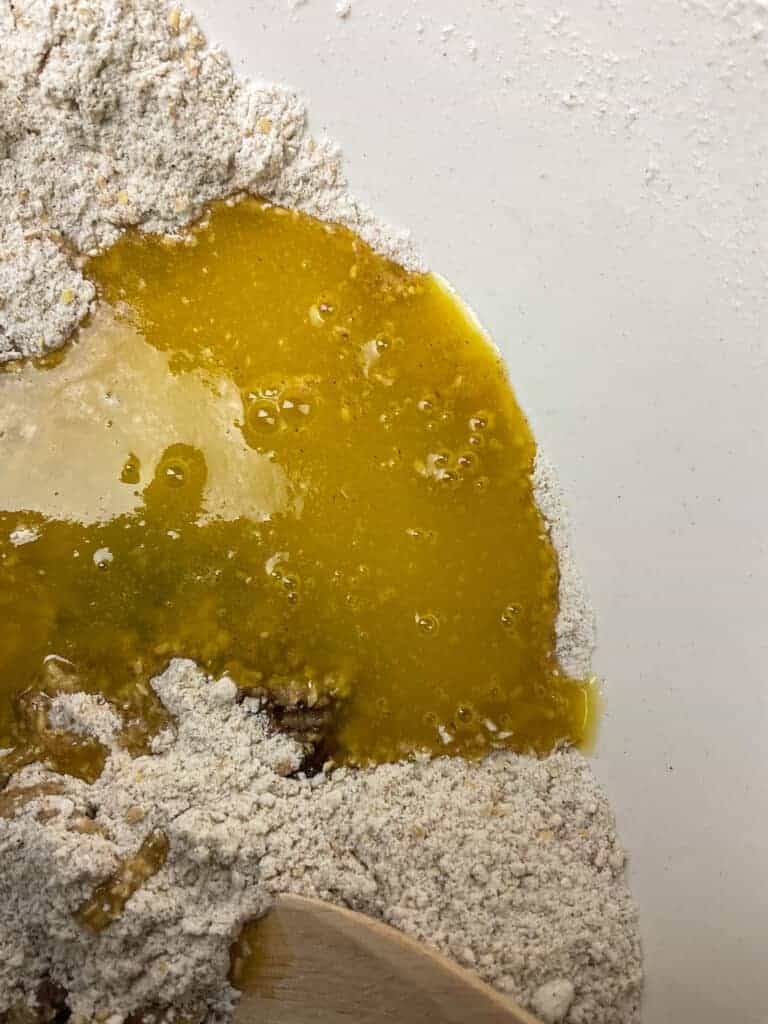
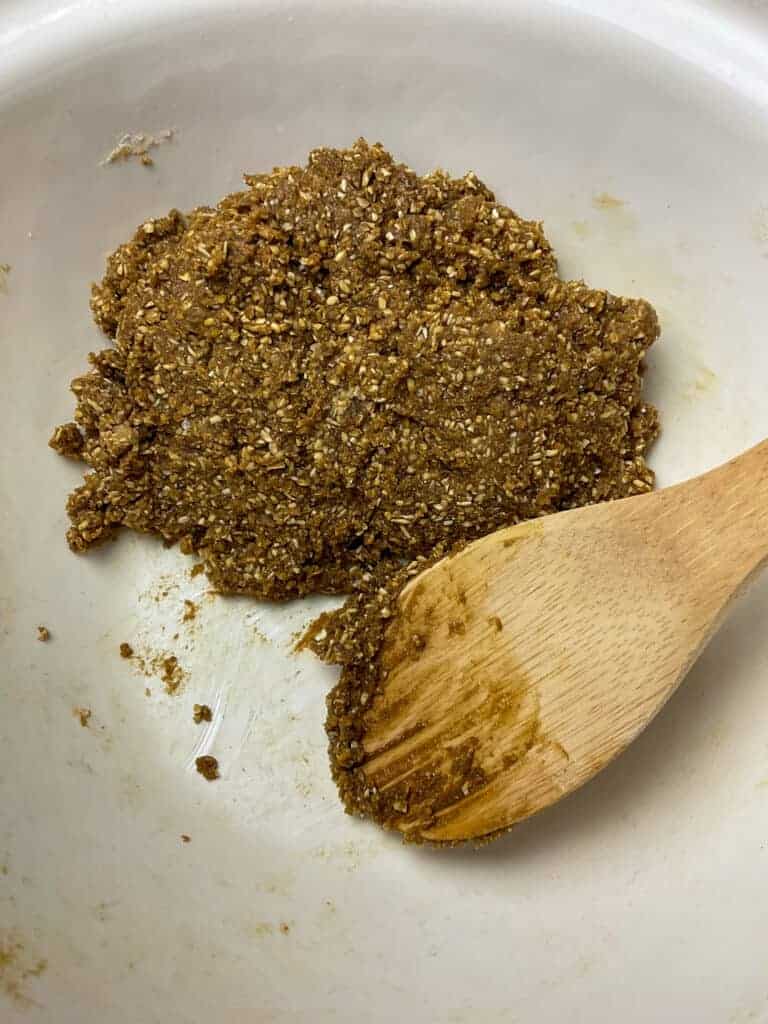
Step 4: Pour the melted margarine into the mixing bowl and mix everything together until it comes together into a biscuit dough.
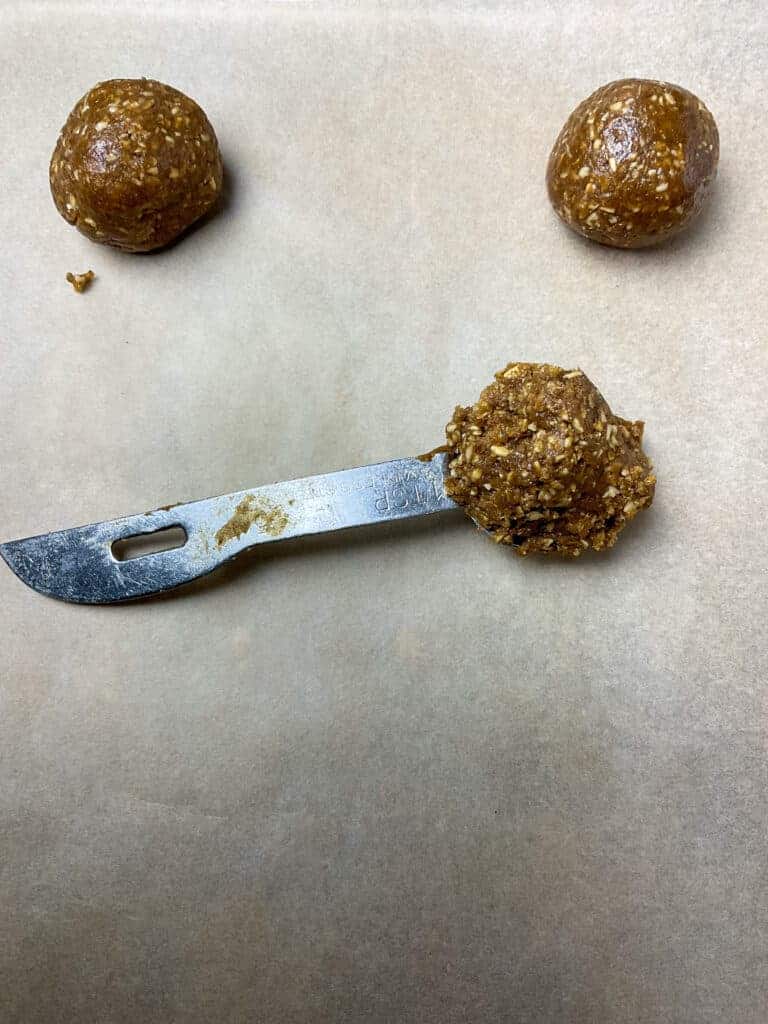
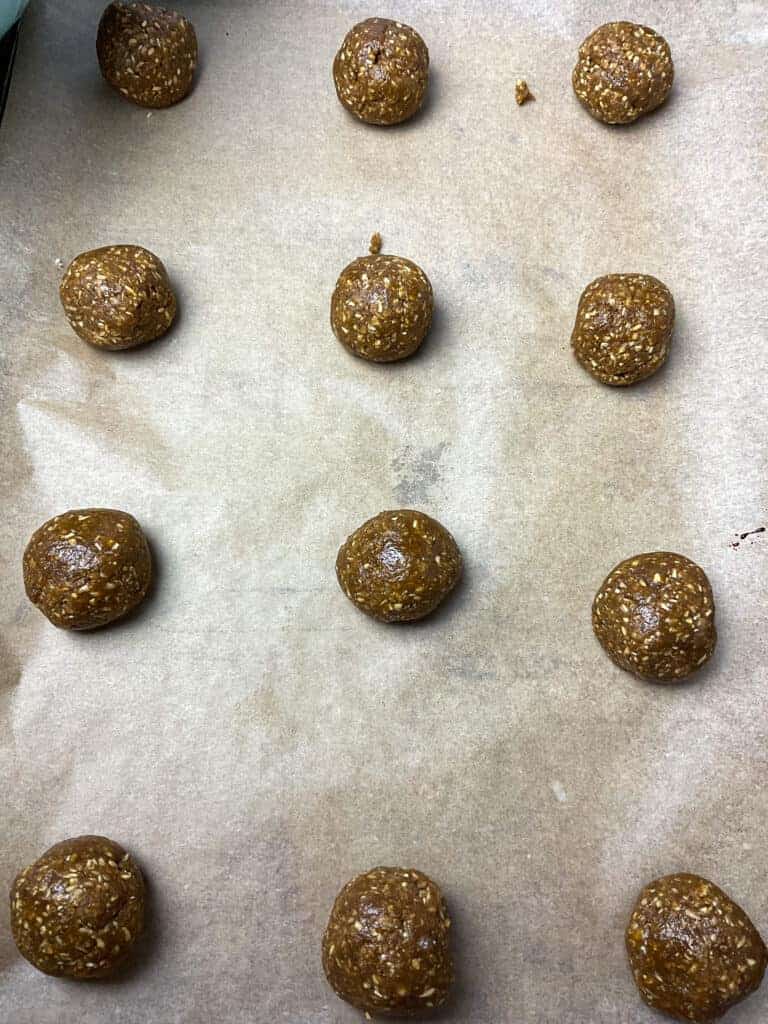
Step 5: Scoop up heaped teaspoonfuls of biscuit dough and roll the dough into a smooth biscuit ball.
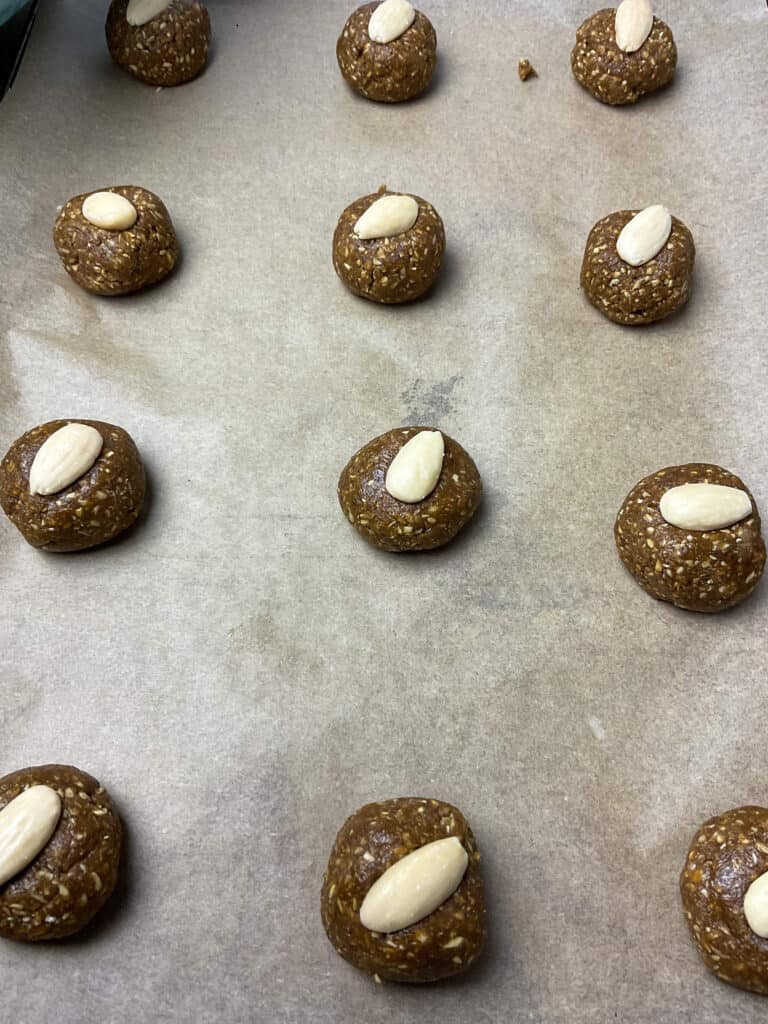
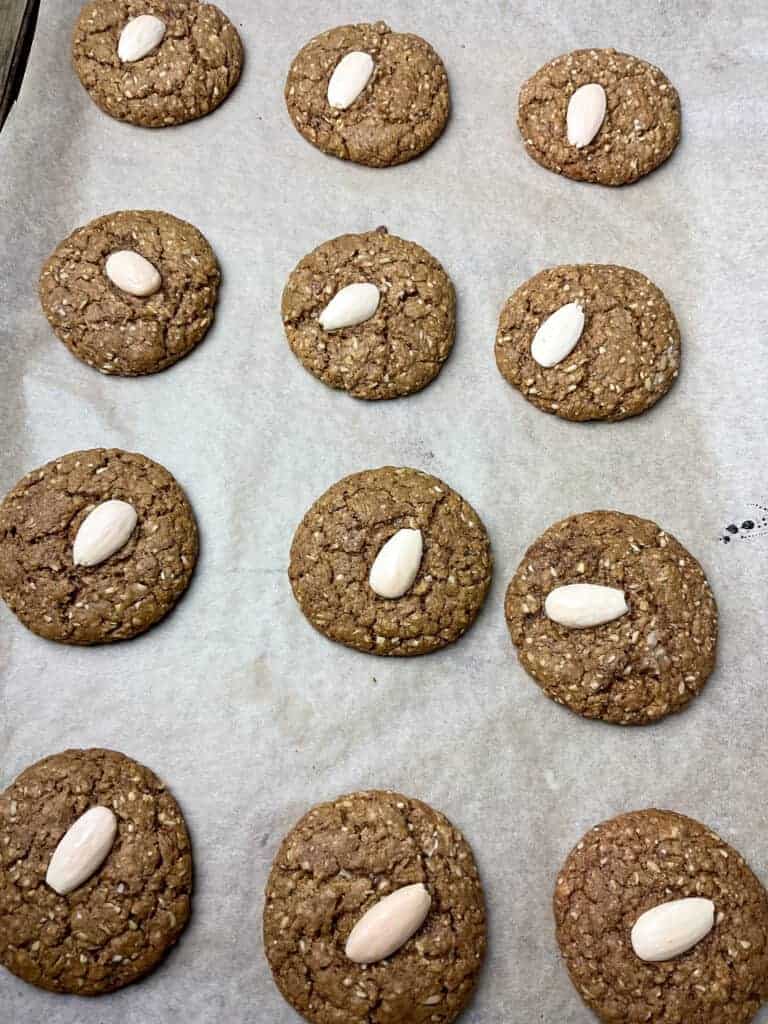
Step 6: Gently press a whole or halved almond onto each biscuit.
Step 7: Bake for 15 minutes.
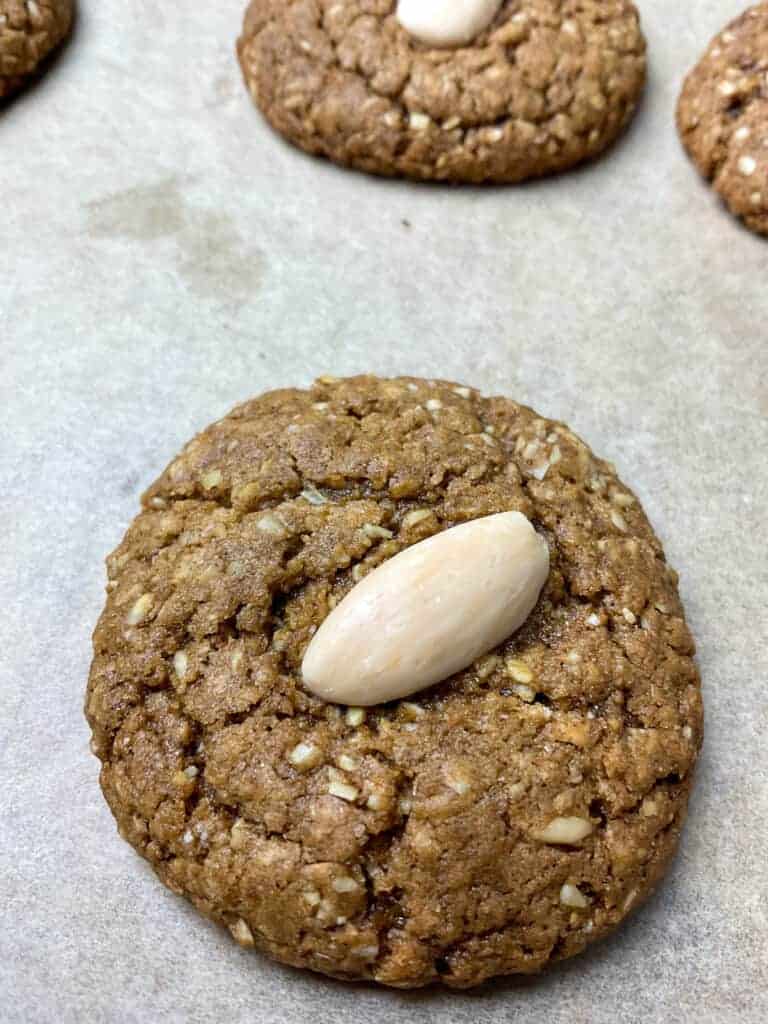
Step 8: Cool on a wire rack.
📋 Recipe notes
⏲️ Storage
Store the biscuits within a cookie jar, biscuit tin, or food container. If storing within a plastic type food container wrap in a layer of parchment paper and a layer of kitchen foil. Store for 5-7 days, possibly longer if stored in a cool and away from sources of moisture.
Or freeze for 2-3 months, well wrapped in food wrap, a layer of kitchen foil and perhaps also pop the biscuits into a freezer bag.
🧾 FAQ'S
Black treacle is a thick, dark syrup that's a by-product of refining sugar. It has a rich, slightly bitter flavour and is commonly used in traditional British baking to give richness and a unique treacly taste to bakes like gingerbread, treacle scones, treacle buns, Christmas puddings, Clootie dumplings, and, of course, parkin biscuits and parkin cake.
No, black treacle and golden syrup are not the same. Black treacle, similar to molasses, is a dark syrup with a rich, slightly bitter flavour, and is the result of the third boiling in the sugar-making process. It's thicker and has a much stronger almost liquorice flavour compared with golden syrup.
Golden syrup is obtained from the first boiling of the sugarcane and is lighter in colour and flavour. It has a texture similar to honey and is much sweeter and more buttery in taste compared to black treacle.
While they can sometimes be substituted for each other in recipes depending on the desired outcome, they will impart different flavours and colours to the finished bake. In parkin biscuits, replacing black treacle with golden syrup will result in a lighter, sweeter biscuit.
Yes, black treacle can be replaced if its difficult to source. You can use molasses for a similar rich treacle flavour, although molasses can be a bit stronger so perhaps go with a mild molasses. Golden syrup is a lighter, sweeter alternative that will still give you the stickiness and moisture that the treacle provides, but with a milder taste.
For a nut-free parkin biscuit you could use a few seeds such as a pumpkin or sunflower seed as these will toast nicely in the oven and provide extra texture similar to the almond. Alternatively, for those who need to avoid all types of seeds, you could top the biscuits with a piece of candied cherry or candied fruit peel, or omit the topping.
The type of oatmeal that is best for parkin biscuits is known as Scottish oatmeal or medium oatmeal or baking oatmeal. This type of oatmeal has been ground into a finer, less coarser textured oatmeal compared to pinhead or steel-cut oatmeal.
Below is an image of the oatmeal we used for this recipe - Hamlyns Scottish Oatmeal which was sourced from our local Co-op supermarket [UK].![]()
If you can't find medium oatmeal, or an oatmeal which states on the packaging that it is suitable for baking, then you can use steel-cut oatmeal, pinhead oatmeal or Irish oatmeal. The texture of the biscuits will be slightly more coarser but they will still be tasty.
Alternatively, add the steel-cut oatmeal to a blender or grinder and pulse a few times to get a finer texture. Its important to know that although medium oatmeal may be ground, it is not the same as oat flour as the texture is still little bits of oatmeal.
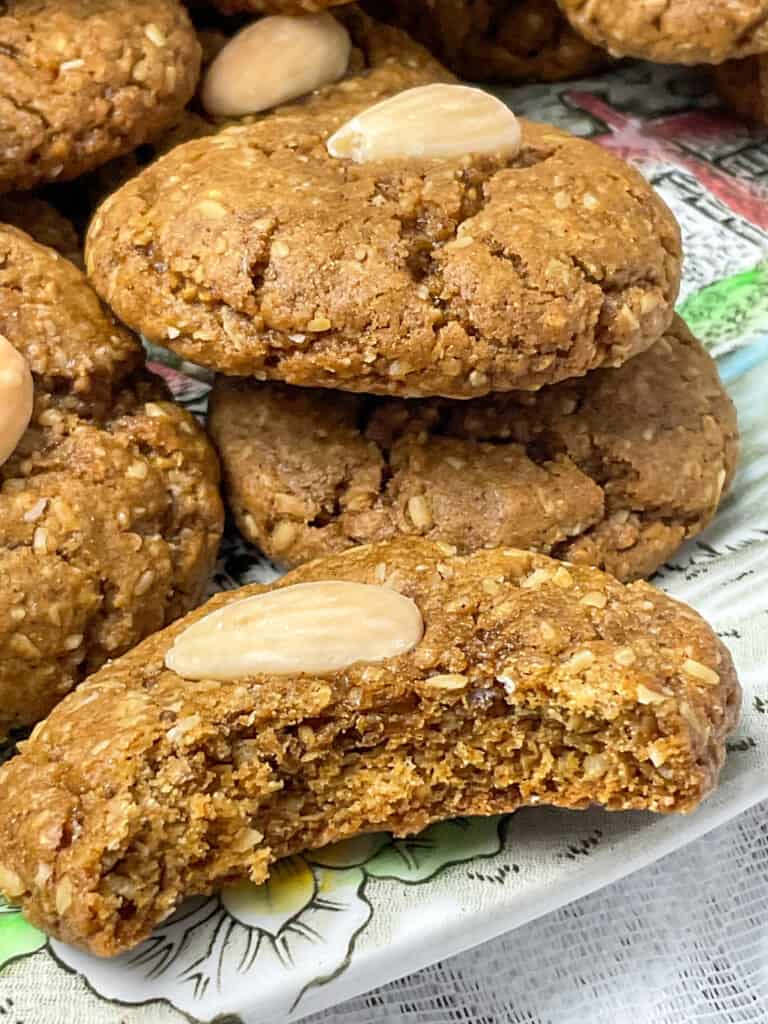
These Parkin biscuits have all the flavours of traditional Parkin cake, they are rich with treacly syrup and oaty like a British hobnob biscuit, and warmly spiced with ginger and cinnamon. They are crisp on the outside and softer on the insides with the rustic textures of oatmeal. The flavours and textures will continue to develop as they sit in the biscuit tin. If you love parkin cake, gingerbread cake, or ginger nut or hobnob biscuits then you'll likely like these tasty biscuits.
More traditional oatmeal biscuits & bar recipes
We have a few more cookies or biscuits, and biscuit bar recipes on our family recipe blog that feature rolled oats or oatmeal as we are a Scottish family and oats play a huge part in our everyday diets! Our family favourites for filling up the biscuit tin are these Old-Fashioned Oatmeal Cookies and this variation Old-Fashioned Oatmeal Raisin Cookies. Our kids particularly love these biscuit bars Chocolate Flapjacks and Scottish Flapjacks which are so easy to prepare and perfect for lunch boxes, tea breaks, and supper time.
***please note: for US measurements click the 'US customary button' within the recipe and the measurements will switch to tablespoons, cups, and ounces.***
📖 Recipe
Traditional Parkin Biscuits
Equipment
- Mixing bowl
- mixing spoon
- Small saucepan
- teaspoon
- Baking paper.
- Baking tray
- cooling rack
Ingredients
- 115 grams plain flour [cake flour/all-purpose flour]
- 115 grams caster sugar [or granulated sugar]
- 115 grams medium oatmeal [steel-cut oats/Irish oatmeal/pinhead oatmeal]
- 1 teaspoon baking powder
- 2 teaspoons ginger powder
- 1 teaspoon cinnamon powder
- 1 pinch salt [we use sea salt]
- 57 grams margarine or butter [we used Stork baking spread]
- 46 grams black treacle [or molasses] [can replace with golden syrup] [just over 2 tablespoons]
- 30 millilitres milk [we use soya milk but you can use your usual milk]
Decoration: [optional]
- 21 almonds [skinless/blanched] [alternatively use a halved almond for each biscuit]
Instructions
- Preheat the oven to 180°C / 160°C fan / 356°F / Gas mark 4.
- Line a baking tray with baking paper. [if you can only bake one tray at a time and the biscuits do not all fit on the one tray, the mixture will be fine to sit on the counter top until the first round of biscuits are baked]
- Over a low heat, gently melt the margarine in the small saucepan and set aside.57 grams margarine or butter
- Add the flour, baking powder, sugar, oatmeal, salt, ginger and cinnamon powder to the mixing bowl and stir everything together until thoroughly combined.115 grams plain flour, 115 grams caster sugar, 115 grams medium oatmeal, 1 teaspoon baking powder, 2 teaspoons ginger powder, 1 teaspoon cinnamon powder, 1 pinch salt
- Make a little well in the centre by pushing some of the mix to the side to expose the bottom of the mixing bowl. Scoop the black treacle into the well, along with the milk and melted margarine.30 millilitres milk, 46 grams black treacle
- With a mixing spoon, stir the mixture together until it sticks together into a biscuit dough. This may take a few minutes.
- Using a teaspoon scoop up heaped amounts of biscuit dough and using the palms of your hands roll each ball into a smooth biscuit ball. Each cookie dough ball will weigh about 20-23grams [about ¾ oz].
- Leave at least 1 inch to 1 ½ inch [2-3cm] between each biscuit.
- Press a whole or halved almond gently into each biscuit, but don't press down too hard.21 almonds
- Bake on the middle shelf of the oven for 15 minutes. [check fan ovens a few minutes before the 15 minute mark as these ovens tend to cool quicker]The cookies will have spread but will not be too thin, and will have darkened and be firm to the touch. Don't press too hard as the biscuits will be soft inside but will firm up more as they cool.
- Leave the biscuits to cool on the tray for at least 5 minutes before removing to cool completely on a cooling rack.
Notes
- Nutritional information is provided for guidance only and is not an exact calculation as ingredients vary.
- Store Parkin cookies within a cookie jar, biscuit tin or food container.
- If storing within a plastic type food container wrap in a layer of parchment paper and a layer of kitchen foil.
- Store for 5-7 days, possibly longer if stored in a cool, dry and dark area.
- Or freeze for 2-3 months, well wrapped in food wrap, a layer of kitchen foil and perhaps also pop into a freezer bag.
- Black treacle can be replaced with light molasses or golden syrup.
- The margarine we used was Stork baking spread which is vegan-friendly.
- It's best to use an oatmeal that is intended for baking, and this is sometimes called 'medium oatmeal' or 'Scottish oatmeal' which is ground to a fine consistency. Although medium oatmeal is ground it is not exactly flour-like in texture, it is just smaller and finer compared to steel-cut oatmeal.
- However, you can also use steel cut oats, pinhead oatmea, or Irish oatmeal.
- The oatmeal used for this recipe was Hamlyn's Scottish Oatmeal which we sourced in our local Co-op [UK].
- We are a plant-based family recipe blog so all our ingredient recommendations are for vegan-friendly ingredients - such as soya milk and dairy-free margarine - however if you have different dietary requirements you can use your usual ingredients.
Nutrition
Comments
Prepared these Traditional Parkin Biscuits? Do let us know how you got on by dropping us a comment below, and clicking the recipe star ratings above. All feedback is very much appreciated. Thanks so much! Jacq x
Sue R says
Delicious, quick and easy to make. Please note that in the recipe given at bottom (not the stages one with photos) there is no mention of the vegan margerine once set aside, though I knew when to add it. I used whole unblanched almonds on mine and they were fine. Will make again soon. Thanks 😊
Jacq says
Thanks so much for pointing that mistake out! I do appreciate it. I've added in that step now. I'm really happy you enjoyed the parkin biscuits 🙂